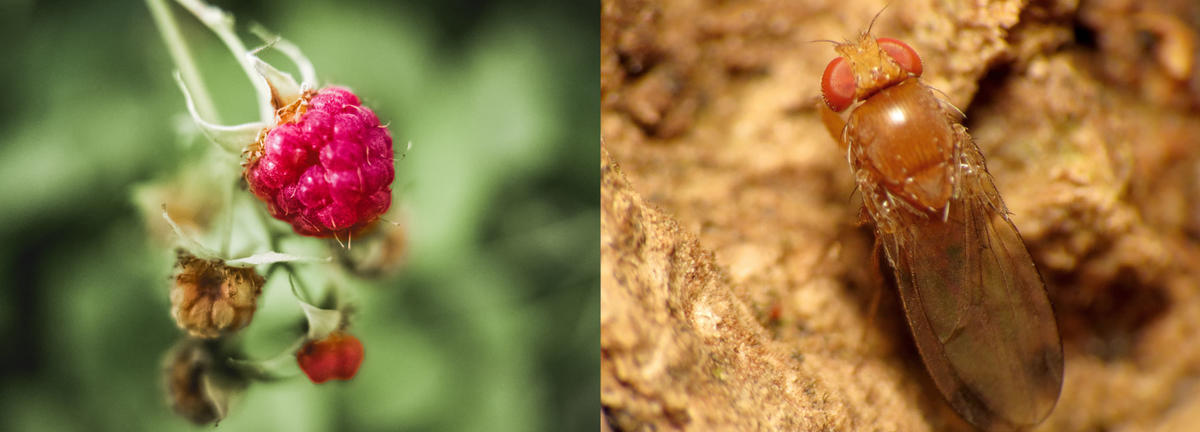
Left: raspberry damaged by spotted wing drosophila; right: spotted wing drosophila.
Header image credit (right): "Spotted-winged drosophila" by Katja Schulz is licensed under CC BY 2.0
Project phases
Background
Researchers are working towards genetic control of a major fruit pest, the spotted wing drosophila (Drosophila suzukii, SWD), by interfering with its ability to reproduce. By preventing new generations from developing, this technology has the potential to drastically reduce Minnesota’s spotted wing drosophila population.
The new method will first be tested in the common fly, Drosophila melanogaster, and later adapted to SWD. If successful in the lab, the technology holds promise for field application tests (phase II) and future expansion into other pest and insect models. Research will also produce valuable secondary information about the genetic diversity within seasonal spotted wing drosophila populations, which could help determine the starting point of invasion.
Research questions
- Can genetic engineering produce males of D. melanogaster that prevent wild-type females from reproducing?
- Can genetic engineering produce males of spotted wing drosophila that prevent wild-type females from reproducing?
- What level of genetic diversity is observed in local seasonal populations of the spotted wing drosophila?
Practical implications
The long-term goal of this work is to develop a new genetic technology for use in the biocontrol of various invasive insects and diseases. The technology also has important implications for preventing GMO gene flow.
The SWD model of this project will provide relief to the Minnesota fruit production industry, which loses millions of dollars annually to the pest.
This project has a multi-phase plan. Success in phase I will provide experimental evidence that the system works in tightly controlled laboratory environments. Phase II will incorporate greenhouse trials, stress testing, and additional safety measures. The long-term goal of this research is a EPA/USDA-approved field trial.
Background
The second phase of this project focuses on the novel approach of biocontrol called “engineered genetic incompatibility” (EGI). EGI leverages the latest genetic tools to engineer species-like barriers to reproduction. Researchers will continue their efforts to produce a biocontrol EGI strain of Drosophila suzukii based on the successes found during phase 1 on species D. melanogaster.
Research questions
- What is the robustness of biocontrol in non-laboratory, diverse environments?
- What is the mechanism of action for hybrid lethality?
Practical implications
Researchers will develop a new class of genetic techniques that address several of the pitfalls with the Sterile Insect Technique (SIT) approaches. They will also collect data that will allow them to file applications to regulatory agencies and develop an agent-based simulation model for SWD, all in preparation of field trials. Ultimately this work will result in proof-of-concept biocontrol agents for SWD.
The single-insect genotyping techniques will broadly impact scientists’ abilities to understand and track population genetics of invasive insects.
Background
During phases 1 and 2, this research team established solutions for genetic biocontrol of the insect pest, spotted wing drosophila (Drosophila suzukii, SWD). Questions remain about scientific and economic issues that may impact the development and success of any genetic biocontrol campaign against SWD, including the method developed by this team. In particular, it is important to understand how genetic and behavioral diversity in wild populations of SWD will impact the effectiveness of a genetic biocontrol treatment.
Research questions
- What are assortative mating behaviors in wild sub-populations of SWD?
- What is the impact of mass-rearing environments on SWD fitness and fecundity?
- Through a techno-economic analysis (TEA), what are the capital and operational costs for applications of genetic biocontrol of SWD at regional and national levels?
Practical implications
This research group will be able to identify and mitigate risks to the efficacy of genetic biocontrol in field applications to reduce the population of SWD. The new genetic technology developed will offer an approach to mass-cultivate stable, sexually incompatible insects that addresses concerns with existing Sterile Insect Technique (SIT) approaches.
This work will be an important part of an Integrated Pest Management (IPM) strategy because it will complement existing control methods to directly impact SWD control in fruit production.
Published research from all phases of this project will be generally useful to the community of scientists and technologists working with SWD and related insects.
Outcomes
While the work is ongoing, this research team has demonstrated a powerful new approach to combat invasive insect pests. As a proof of concept, genetically engineered D. melanogaster male insects can successfully mate with wild females, who would not have offspring. This can reduce a wild population and it is applicable to any sexually reproducing insect. They have made progress translating what they learned from D. melanogaster to D. suzukii and made their first transgenic SWD flies.
In addition, the team invented a new approach to sequencing genomes that allowed them to sequence the relevant genes from over 10,000 wild flies. The data is being used in the engineering efforts for SWD.
Publications
- Predicting thresholds for population replacement gene drives (BMC Biology, 2024)
- HUGE pipeline to measure temporal genetic variation in Drosophila suzukii populations for genetic biocontrol applications (Frontiers in Insect Science, 2022)
- Genetically engineered insects with sex-selection and genetic incompatibility enable population suppression (eLife, 2022)
- Modeling-informed Engineered Genetic Incompatibility strategies to overcome resistance in the invasive Drosophila suzukii (Frontiers in Insect Science, 2022)
News and media
- ‘A plague to be reckoned with’: UMN research creates a buzz with invasive fruit fly research (The Minnesota Daily, 2020)
- Research reveals high cost of invasive species for Minnesota-grown raspberries (MITPPC)
- Synthetic species made to shun sex with wild organisms (Nature News, 2018)
- Scientists are engineering GMO species to self-destruct after breeding in the wild (ScienceAlert, 2018)
- GMO Safety Factor Prevents Fruitful Interbreeding in the Wild (Genetic Engineering & Biotechnology News, 2017)
- New way to prevent genetically engineered and unaltered organisms from producing offspring (EurekAlert!, 2017)